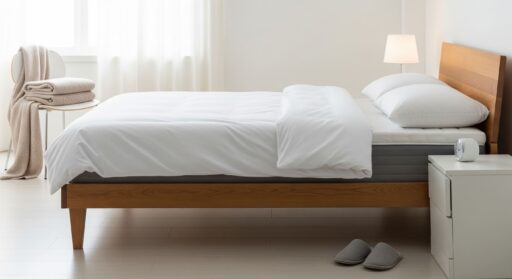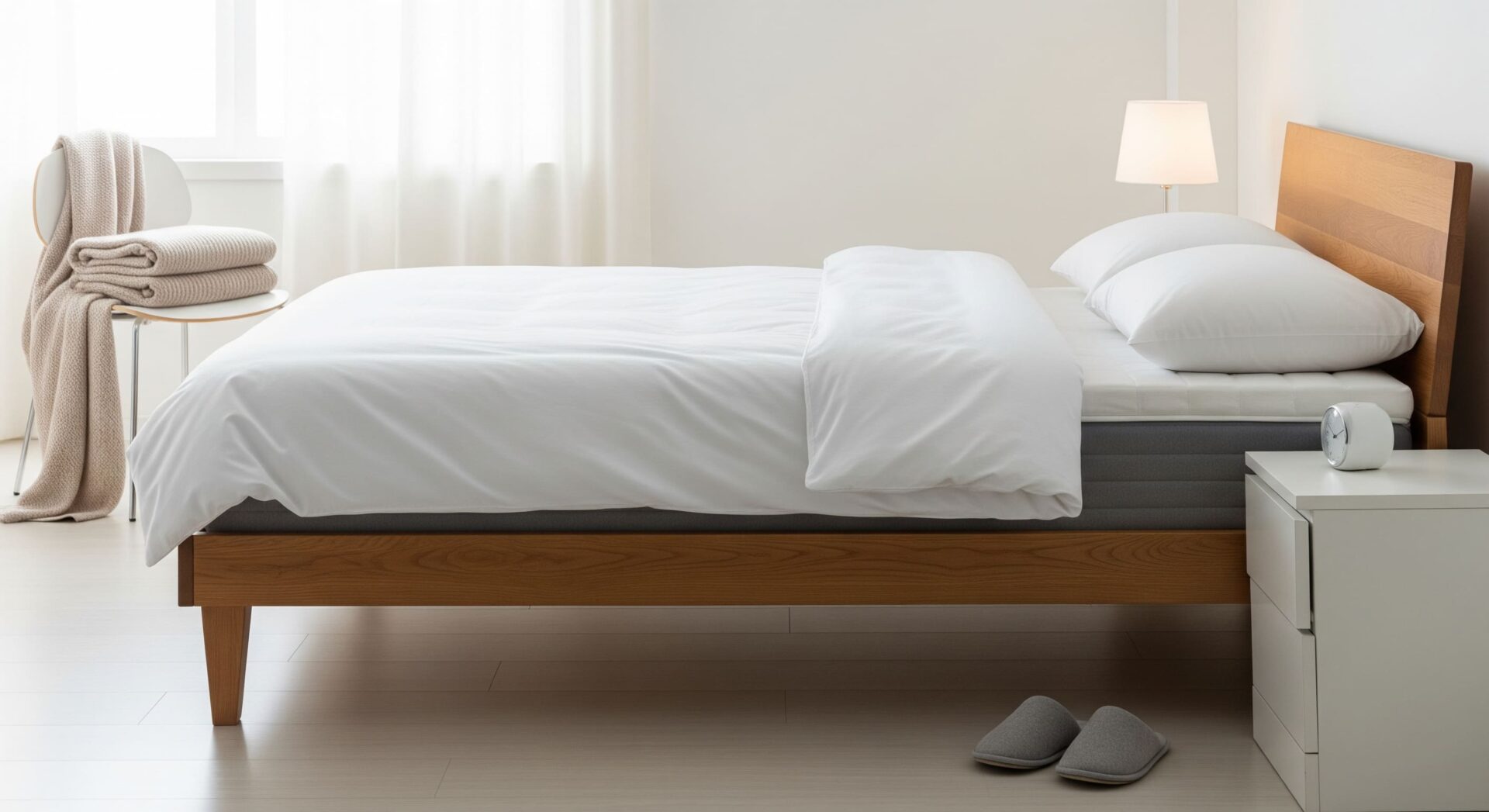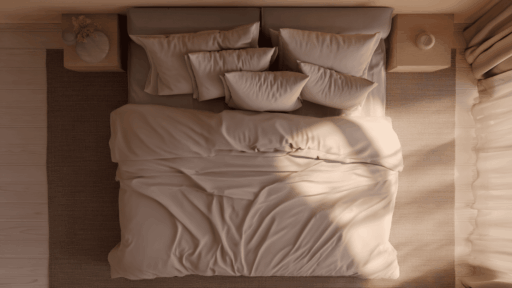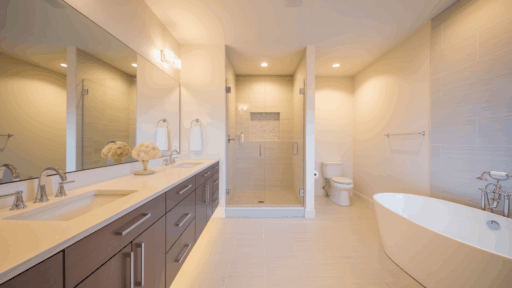Getting good sleep isn’t just about how soft or firm your mattress is; it also depends on how high your bed sits.
Many people don’t realize that both average bed height and standard mattress height play a big role in comfort, safety, and how easy it is to get in and out of bed.
If you’re short, tall, or starting to feel stiff with age, the wrong bed height can make everyday movement more difficult.
In this guide, we’ll walk you through the most common bed and mattress heights, why they matter, and how to choose the right setup for your body, bedroom, and daily routine.
What is the Average Bed Height?
The average bed height, measured from the floor to the top of the mattress, typically ranges from 18 to 25 inches for most homes.
Among those, 24–25 inches is considered the standard for ease of use and balance between design and function.
Here’s a quick reference:
| Bed Type | Typical Height (incl. Mattress) |
|---|---|
| Platform bed | 18–20 inches |
| Standard bed (box spring) | 24–25 inches |
| Antique bed | 20–22 inches |
| Modern bed with thick base | 24–30+ inches |
Tip: A bed height close to your knee level is ideal. This makes sitting down and standing up easier and safer.
What is the Standard Mattress Height?
The standard mattress height determines the overall height of your bed setup. Here’s what to expect:
- Low-profile mattresses measure 6–8 inches in thickness, suitable for minimal setups.
- Standard mattresses typically range from 8 to 12 inches in height.
- Luxury and hybrid mattresses offer over 14 inches of plush, supportive comfort.
Many newer beds feature thicker mattresses, so it’s essential to consider this when shopping for frames or bases. Too thick a mattress on a tall bed frame can leave your feet dangling!
Why Does Bed Height Matter for Sleep Quality & Comfort?
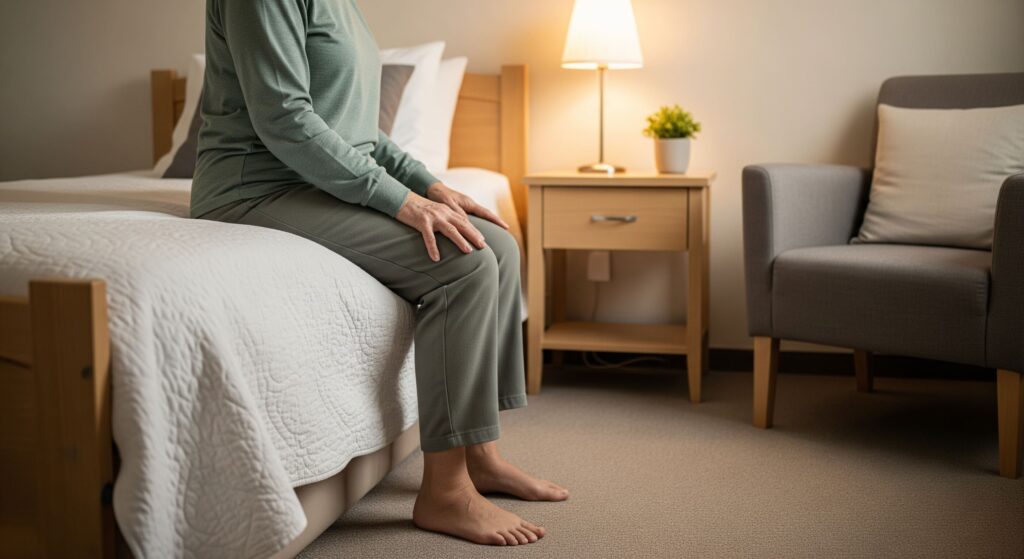
Bed height isn’t just about looks; it plays a big role in comfort, movement, and safety.
The right bed height makes it easier to get in and out of bed, especially for kids, seniors, or anyone with joint pain. If a bed is too low, it can strain your knees and hips; too high, and it might feel unsteady when stepping down.
Proper height also supports better posture. Sitting with your knees at a 90-degree angle helps support your spine and reduce joint pressure. It even improves sleep by making it easier to move and get comfortable.
Visually, bed height affects your room’s style, so choose one that fits both your needs and space.
Finding Your Perfect Bed Height Step by Step
Here’s how to pick the right bed and mattress height for your body and space. Follow these simple steps to find what works best for you.
Step 1: Use the 90-Degree Sit Test
- Sit on the edge of your bed with your feet flat on the floor.
- Your knees should be level with or slightly below your hips.
- If your knees are higher, the bed is too low. If your feet dangle, it’s too high.
Step 2: Consider Your Height
Your body height affects how high or low your bed should be:
- Shorter than 5’5″: Ideal bed height 20–23 inches
- Between 5’5″ and 6′: Ideal bed height 24–25 inches
- Taller than 6′: Ideal bed height 26–30+ inches
Step 3: Factor in Mobility or Health Needs
If you have back pain, arthritis, or limited movement:
- Choose a bed height that requires little effort to sit or stand.
- Avoid very low or very high setups, aim for 20–23 inches for easiest access.
Step 4: Measure Mattress Thickness
Mattress height adds to your total bed height, so choose wisely:
| Mattress Type | Typical Height | Best For |
|---|---|---|
| Low-profile mattress | 6–8 inches | Minimalist frames or kids’ beds |
| Standard mattress | 8–12 inches | Balanced comfort and versatility |
| Luxury/hybrid mattress | 14+ inches | Plush support but raises bed height |
Important: Make sure your frame and standard mattress height combine to keep your bed comfortable and accessible.
Step 5: Match Bed Height to Your Room Style
- Low beds (18–22): Sleek, modern, space-saving
- Medium beds (22–25): Classic and adaptable to most styles
- Tall beds (26–30+): Traditional, dramatic, great in large rooms
Once you’ve gone through these steps, you’ll have a bed height that supports your sleep, fits your room, and feels just right every time you lie down or get up.
Guidelines for When to Adjust Your Bed’s Height
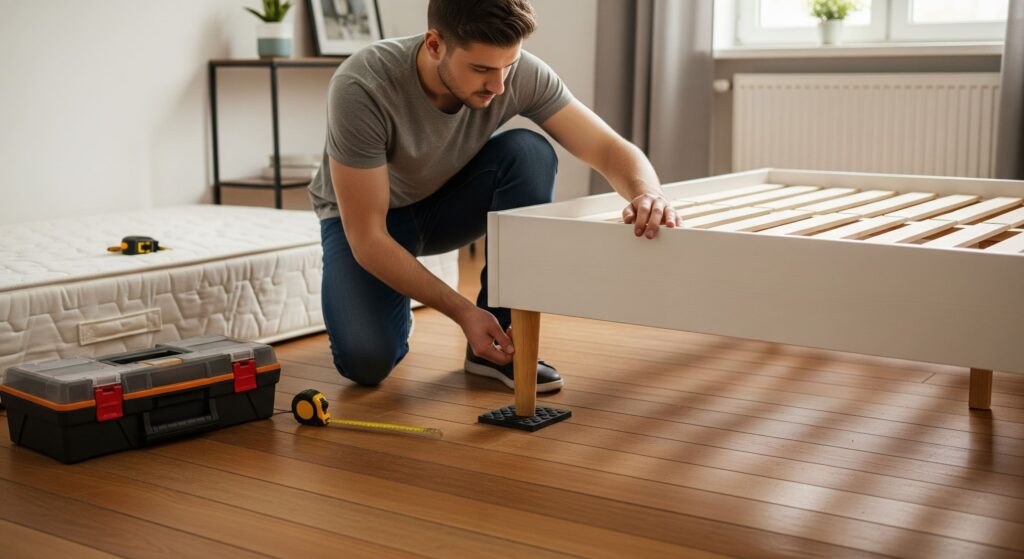
Do you need to tweak your current bed setup? Here are simple fixes:
How to Lower Bed Height
- Use a lower-profile mattress (8–10 inches)
- Swap out tall frames for platform beds
- Remove the box spring if not needed
How to Raise Bed Height
- Use a thicker mattress (12–14+ inches)
- Add risers or under-bed storage blocks
- Try adjustable bed bases with incline options
DIY tip: Use furniture sliders or rubber pads under the legs to slightly lift your bed safely without a major investment.
Wrapping it Up
Choosing the right average bed height and standard mattress height may not seem like a big deal, but it can improve your sleep, comfort, and safety more than you think.
For most adults, a total height of approximately twenty-five inches from the floor to the top of the mattress is ideal.
It’s always a good idea to measure and think about your height, comfort, and how easily you move. Mattress thickness, frame style, and your daily habits all play a part.
So, setting up a new room or replacing an old bed, this guide can help you choose a setup that feels just right for you.
Frequently Asked Questions (FAQ)
Can adjustable bed bases affect optimal bed height?
Yes, adjustable bed bases can raise the overall height by several inches. Always measure from the floor to the top of the mattress when the base is in its resting position.
Do storage beds alter the recommended height?
Yes, storage beds with deep drawers can raise the total height. Always measure the entire setup, including the frame and mattress, before making a purchase.
Does frame material affect height flexibility?
Yes, metal frames tend to offer more height flexibility, while wood or upholstered frames are usually fixed and less adjustable.
Can I adjust the height of my frame at home?
Yes, you can adjust the height of your bed at home by using bed risers to raise it or removing casters or slats to lower it.
What bed heights work for small rooms?
Low-profile beds, typically between 16 and 20 inches, work well in small rooms by creating a more open feel, although they may offer less under-bed storage space.

